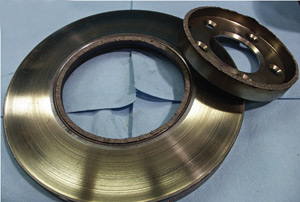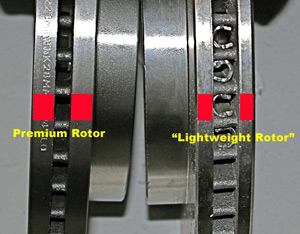Application: All vehicles
Symptoms: Glazed pads, heat checking and cracking of the rotor, and brake noise.
Cause: Rotors with reduced weight and plate thickness, and improper vane configuration.
Condition: If a customer complains of noisy brakes, increased stopping distances and pedal pulsation after brake rotors were replaced or machined, the rotors may be the source of the problem. It’s easy to blame the pads or brake hardware, but technicians need to look at the rotor.
 Affinia Global Brake & Chassis (manufacturer of Raybestos Brand Brakes and rotor supplier to NAPA and ACDelco) discovered during a recent benchmarking study of the competition that some rotor companies have reduced their plate thickness by expanding the air gap and reducing the weight of their vented rotors. The study revealed that rotor mass for some rotors was reduced by 7- to 24-percent. On applications such as GM full-size trucks, Affinia Global Brake & Chassis reported a weight reduction of 5-lbs., from 26 lbs. to 21 lbs., when compared to the OE part.
Affinia Global Brake & Chassis (manufacturer of Raybestos Brand Brakes and rotor supplier to NAPA and ACDelco) discovered during a recent benchmarking study of the competition that some rotor companies have reduced their plate thickness by expanding the air gap and reducing the weight of their vented rotors. The study revealed that rotor mass for some rotors was reduced by 7- to 24-percent. On applications such as GM full-size trucks, Affinia Global Brake & Chassis reported a weight reduction of 5-lbs., from 26 lbs. to 21 lbs., when compared to the OE part.
In addition to increasing the air gap to reduce weight, other changes were discovered, including different vane configurations and materials used to cast the rotor. The reduction in vane mass causes material strength to decrease at the vane/surface plate interface and can lead to the possibility of failure. These changes can reduce costs and do not conform to OE specifications.
 Brake rotors are safety-related components and should never be compromised. Less mass means decreasing the heat resistance of the rotor. Heat energy that flows into the rotor is inversely proportional to thermal resistance to conduct heat flow. By reducing the mass it increases thermal resistance, causing the rotor to become hotter during operation. This will result in brake fade, “warpage,” pedal pulsation, rotor cracking, uneven friction wear, material transfer and reduced friction pad life. Also, if the rotor is not able to absorb and dissipate the heat, the system will run hotter and the extra heat is transferred to the pads, caliper piston and eventually the brake fluid, ultimately resulting in brake fade, increased pedal travel and longer stops.
Brake rotors are safety-related components and should never be compromised. Less mass means decreasing the heat resistance of the rotor. Heat energy that flows into the rotor is inversely proportional to thermal resistance to conduct heat flow. By reducing the mass it increases thermal resistance, causing the rotor to become hotter during operation. This will result in brake fade, “warpage,” pedal pulsation, rotor cracking, uneven friction wear, material transfer and reduced friction pad life. Also, if the rotor is not able to absorb and dissipate the heat, the system will run hotter and the extra heat is transferred to the pads, caliper piston and eventually the brake fluid, ultimately resulting in brake fade, increased pedal travel and longer stops.
These “low mass” or “lightweight” rotors can also cause noise problems. The plates and vanes of an OE rotor are tuned specifically for the vehicle to absorb or dampen noise and vibration.
If you are machining a rotor on a lathe, look at the thickness of the rotor’s plates. Rotors with thinner plates have less material on the plates to machine. Even if the rotor is above the discard specifications, the rotor may not be safe to put back on the vehicle.
If you do encounter a situation where noise has caused a comeback, follow the below procedure:
Inspection and Repair Procedure:
1. Examine the rotor for signs of heat checking and cracking. Make sure to check the collar (area where the hub meets the plate) and the outer edge. If any cracks or mechanical damage are found, the rotor must be replaced.
2. Compare the thickness of the rotor plates to an OE or premium-quality rotor. If possible, weigh the rotor on a scale and compare. If the weight and plate thickness are significantly below the OE or a premium-quality rotor, replace the rotor.
3. Measure runout in the rotor and wheel bearing with a dial indicator. Also, check the thickness of the rotor with a micrometer. On most vehicles, lateral runout greater than 0.002” will generate a pulsation complaint.
Note: If a new rotor is installed, it is not necessary to machine the rotor.
4. Inspect the caliper piston boots for heat damage. The material should be defect-free and pliable. The boots can be damaged by the elevated temperatures and will even catch fire. Any damage to the boot will cause an increased rate of wear to the caliper seal. Replace the damaged boot or caliper, if necessary.
5. Reassemble the caliper and bracket. Lubricate all slides, pins and hardware with the appropriate lubricant.
6. Replace the brake pads if they are glazed or show other signs of other mechanical damage like edge lift. Often, the extreme heat will change the chemical structure of the friction material and cause it to separate from the backing plate.
7. Test-drive the vehicle. If new pads were installed, perform the manufacturer’s recommended break-in procedure.
Courtesy of Affinia Global Brake & Chassis.
For more information about Raybestos brand brakes, visit www.raybestos.com.













